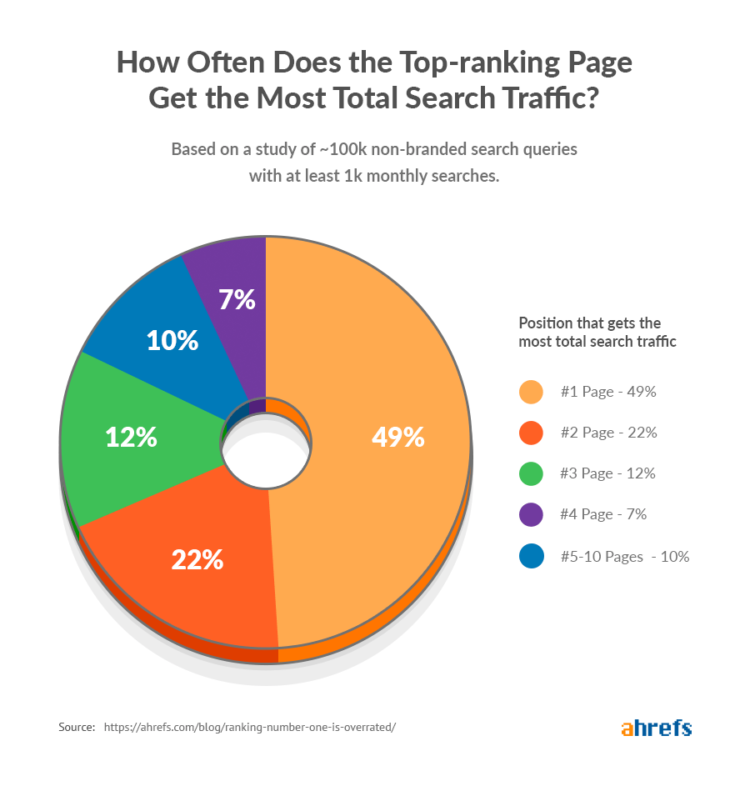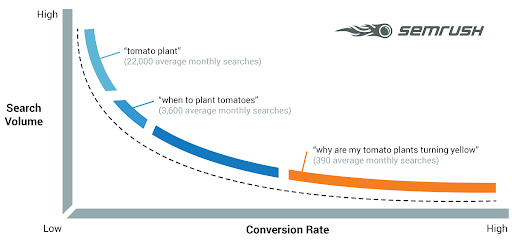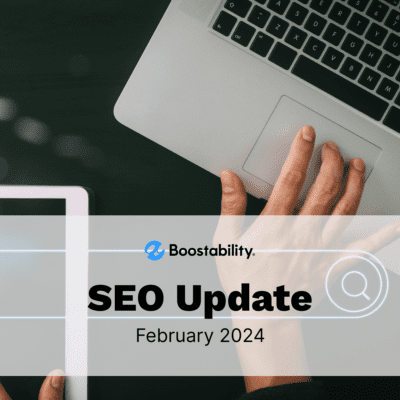Having spent over a decade in the SEO space, we’ve seen a lot of changes as Google continues to innovate and make its algorithm more user-friendly. Ultimately that’s the goal of SEO, to improve your website in the eyes of Google so it shows up higher in the search results. However, after so many years of adaptations to the algorithm, optimizing the SEO process, and having over 200 ranking signals, there are several misconceptions about SEO that have cropped up and won’t go away. So today we’re going to debunk some of the greatest SEO myths out there and set the record straight with the facts.
Table of Contents:
- 23 Common SEO Myths and Facts
- People make interpretations
- SEO is dead
- SEO is a one-time thing
- It’s all about search volume
- Keywords need to be used a certain amount of times
- Keywords should always stay the same
- Only exact match keywords will rank
- All backlinks are created equal
- Backlinking is a thing of the past
- Content isn’t that big of a deal
- Only new content ranks on Google
- Larger content is what ranks best
- Domain authority determines the quality of your website
- You can increase your domain authority quickly
- SEO is not working unless you’re ranking #1
- Mobile optimization isn’t necessary if your traffic is primarily desktop users
- Other website factors don’t matter
- Social signals improve SEO
- Google Ads help you rank for SEO
- There’s no such thing as too many 301 redirects
- Duplicate content isn’t a concern anymore because of canonical tags
- SEO is expensive
- SEO is only for big companies
23 Common SEO Myths and the Facts to Set the Record Straight
1. People make interpretations
Sometimes the advice and information that is published by Google’s own practitioners is vague and left open to interpretation by SEOs and webmasters. This doesn’t discount the professionals that have tested out theories and have data to back up their claims, those are valid. It’s the ones that don’t test out theories and the advice that’s released by Google and make statements about tactics that will boost or hurt your SEO campaign. And from there, it spreads like wildfire.
2. SEO is Dead
Google is smart enough to know the second a domain gets registered. It constantly crawls the internet for the most relevant websites out there to deliver results for every query. Every little while, there’s a headline saying “SEO is Dead” and that the tasks currently in play no longer matter. Things like content is dead, links are dead, crop up, too. But that’s not the case and those are just misconceptions about SEO.
Those kinds of headlines are mostly just clickbait. But they keep cropping up. Tried and true SEO methods will not die. Boostability, like other SEO companies, uses millions of bits of data to help us understand the algorithm and make informed decisions for our SEO customers. But things like good content and strong backlinks will never die when helping to improve a website.
SEO has not been immune to automation either. Some aspects of it have been improved upon and simplified as a result of automation which benefits both search engines and the end-user. But the human-factor of SEO that Google values so much cannot come from robots, it comes from people. SEO experts write for both humans and for search engines. And people can make intuitive decisions, such as determining whether a backlink that’s been flagged as spam according to one tool’s algorithm is actual spam or a relevant backlink that can enhance your SEO.
3. SEO is a one-time thing
This is wrong and one of the misconceptions about SEO we hear the most! SEO is definitely not a one-time project if you want it to be sustainable and drive results. At the rate that algorithms change, SEO is constantly evolving. Google’s algorithms are getting better at understanding searcher intent and differentiating between quality content and links, natural language processing, websites that serve optimal user experience, and much more. This is why SEO strategies need to progress and improve along with it. And that’s why SEO requires ongoing maintenance because once is simply not enough.
4. It’s all about search volume
We hear this a lot from clients that have been led to believe that they should only be targeting keywords with the highest search volumes. It’s a common SEO myth but the fact is that it’s only a factor to be considered in the overall keyword strategy, not the sole factor. Keyword intent is arguably the most important factor because there’s no point in optimizing your website for a keyword that doesn’t match what you do or what your target audience is looking for. If you don’t focus on intent, you won’t get much in return from your SEO campaign.
In regards to search volume, keywords with high traffic are great because they have the potential to capture a lot of attention and search visits. But they also come with higher competition and keyword difficulty, so it’s harder to rank for them. On the other hand, long-tail keywords may have lower search volumes, but they typically have lower competition and can be easier to rank for. Incorporating both high search volume terms and long-tail keywords into your keyword strategy is a smart approach because you can capture some quick wins while working to boost your authority and positioning for high search volume keywords that require time (several months to even years).
5. Keywords need to be used a certain amount of times
A common misconception about SEO is that you need to use keywords within content a certain amount of times in order for the page to rank. You may have even heard that you should use one keyword every 100 words.
While keywords are certainly still important, this statement is an SEO myth. There’s no specific rule that proves this to be true. It’s more important to focus on creating quality content, using keywords in a natural manner, and placing them in highly visible spots on the page rather than forcing it into a sentence for the sake of the term being used.
6. Keywords should always stay the same
Another common misconception about SEO is that keywords should stay the same and never be replaced. Keyword trends and intent are subject to change just as algorithms are! The picture below shows how the trends for ‘small business SEO services’ changed within the past year.

New keywords can also pop up on the radar while previously top-performing keywords can drop. This is why keyword lists should be refreshed consistently. We like to do an overall keyword refresh every 3-6 months to capture new opportunities and reassess terms that should be replaced or optimized even more.
7. Only exact match keywords will rank
When SEO was just starting out as a new industry, exact match keywords played a stronger role than they do now. But as we mentioned earlier, Google is getting much smarter with understanding websites, content, and language. Exact match keywords still have a role to play in SEO, but it’s a misconception that it’s the only type of keyword that will rank.
Google can understand semantic terms and natural language processing better than ever before so there’s less of a need to target exact match terms now. We have BERT and MUM to thank for that! Google is bridging the gap between writing for SEO and writing for humans.
8. All backlinks are created equal
Before we get into the how of backlinks, we first need to understand the why of it. Backlinks help users navigate between pages on the internet as well as create trust for your website. Essentially, it tells Google that it can trust your website because other websites do. Backlinks equal a digital vote of confidence.
So while we need to build these links, you need to do it in the right way. Just like investing your money, it’s often the most valuable to have a diversified portfolio. There’s 5 different types of link diversification: Link Location, Link Type, Link Quality, Content Type, and Link Scheduling. Essentially it matters WHERE you place links to your website, WHAT kinds of websites you post on, and WHEN you post your links. Google won’t like it if you post dozens of links all over the place in random spots all at once. You need to make sure they’re relevant to your industry, that you post guest articles, or contribute on other websites with other websites with high authority, and at different times. And most importantly, backlinks must be genuine and organic, not a black-hat tactic.
9. Backlinking is a thing of the past
It makes sense why this would be a misconception about SEO with the recent updates rolling out and the major push for enhancing the E-A-T and user experience of a website. However, this could not be farther from the truth. It’s true that user experience and SEO are becoming more integrated and certain page experience factors, like site speed and safe browsing, are expected to be ranking factors.
But link building still plays a vital role in a successful SEO campaign. Google and other search engines are just getting smarter at recognizing which link was obtained organically and which one was a result of a skeptical tactic. It’s also essential to ensure that backlinks are obtained from reputable and trusted sources. Quality over quantity every day!
10. Content isn’t that big of a deal
Of all the SEO myths to dispel, this is one of them that needs to be at the top of the list. By mentioning above that link building is still a vital factor in SEO, we’re not saying it’s the only factor. Content is key and content has been proven to be one of the most effective ways to improve user experience, demonstrate proper E-A-T, and recover from negative side effects as a result of a core update.
A strategic and well-thought out content marketing plan should be a priority for any website, but especially for SEOs. This is how you attract new business, expand your reach, share your knowledge, use keywords to rank for your content, and much more.
11. Only new content ranks on Google
Creating new content with high intent keywords definitely matters. It’s important to do so and capture opportunities to rank for new topics that your target audience finds valuable and to remain a thought leader in your industry. However, you also need to focus on the content already on your site – this includes pages outside of your blog articles that should still be updated with relevant information and important keywords.
Repurposing existing content is necessary because information can become outdated over time and new data is released. And an older piece that once generated a lot of traffic and leads can be restored to serve your website in that manner once again.
So remember to repurpose and refresh your website to reflect the most accurate, most informative, and most valuable information you can provide to your website visitors. Keywords, links, images, a user-friendly structure can be applied to help it improve in rank for SEO.
12. Larger content is what ranks best
This SEO myth has been trending in recent years as a result of some studies that suggest a correlation between long-form content and a stronger ability to rank in SERPs. It’s difficult to tie that back strictly to word count because there are other factors that contribute to higher rankings including the number of backlinks associated with a ranking page.
Backlinko shares a study where they found that long-form articles typically tend to have more backlinks, which directly affects your rankings. However, there’s no guarantee that a higher word count in your article or page will guarantee a higher position in SERPs.
This should not discourage you from writing long-form content pieces because they are beneficial for numerous reasons. An obvious benefit is the ability to incorporate more keywords into the content. In addition to that, larger content can provide a detailed explanation of a topic, it can include infographics and high quality imagery that’s valuable for link building, and it can cover a range of questions that searchers are looking for accurate answers on.
One rule of thumb, we advise our clients to avoid writing for the sake of a word count and risk being redundant. It’s better to be concise and provide answers quickly and easily for readers than to beat around the bush just so you can reach that 1,500 word count limit everyone keeps talking about. Err on the side of user experience and place yourself in the reader’s shoes!
13. Domain authority determines the quality of your website
Domain authority is definitely one of those important factors for websites to work on improving, but it’s also a relative score that changes depending on tools that calculate it and the algorithms used to quantify a website’s authority. Therefore, it’s tough to only base it off one scoring method and to let that be the determining factor of whether your website is trustworthy or not.
We need to be clear about something: a website’s authority should be improved and increased over time. But it’s not the end-all-be-all of SEO. If you’re a brand new site that has a lot of value to offer to your industry and customers, naturally you will not have a high domain authority. That does not mean that your website is less trustworthy than another site that’s been around for longer and has a higher authority score.
Ultimately, your domain authority will be impacted based on what you’re doing in your SEO campaign. As you work to improve your technical SEO, content, keyword performance, and backlinking, this will have an impact on your domain authority which will also improve as search engines start to recognize that your website is credible and trustworthy. So don’t let that be the main driver of your SEO campaign. Domain authority is the big picture that the rest of your SEO campaign will help you achieve.
14. You can increase your domain authority quickly
Increasing a website’s domain authority takes time. It’s a red flag when agencies claim that they can get you a guaranteed increase in a short time period or specific time frame. Generally, quick wins in increasing domain authority are a result of skeptical tactics that can cause more issues for your website down the road.

Like we mentioned above, your domain authority is influenced by multiple tactics including link building and content development. Success with SEO is not an overnight achievement, it’s a long term strategy and that applies with domain authority improvements.
15. SEO is not working unless you’re ranking #1
A common SEO myth is that your SEO campaign isn’t working unless you’re ranking the first spot on the SERP. Ahrefs did a study that shows that the top ranking result only gets 49% of the traffic. While that’s still a large portion, it’s not a crazy high number that phttps://ahrefs.com/blog/ranking-number-one-is-overrated/eople are led to believe. Your goal should be to rank first for a variety of intent-driven and valuable keywords, but don’t believe that your SEO is not working if you’re not ranking in the first position for every term.

16. Mobile optimization isn’t necessary if your traffic is primarily desktop users
A misconception about SEO is that it’s not necessary to optimize your website for mobile devices if the primary device used by your audience is a desktop device. That doesn’t matter. Google launched Mobile-First Indexing in 2018 and it applies to every website regardless where your traffic comes from. There’s been enough of a shift in mobile device usage to constitute this change and Google’s spiders crawl and index your website from a mobile device first. Therefore, you really need to optimize your website to be mobile-friendly in addition to desktop-friendly.
17. Other website factors don’t matter
While content is definitely key when it comes to SEO, so are other website factors like technical SEO, user experience and functionality, and site speed. An SEO campaign consists of various strategies that work to build up the relevance and trust of a website.
First and foremost, you need a good website and strong technical SEO before you move forward with anything else. Both of those things serve as a sturdy foundation for your SEO campaign so that you can then build upon it with other stuff, like link building, content development, video production, etc. If you focus on the other strategies before technical SEO, your foundation will crumble.
Optimizing your website for faster site speed is also essential. With the heavy precedence of improving Core Web Vitals and other page speed elements in the last year, it’s crucial that this be a priority in your SEO campaign.
18. Social signals improve SEO
There’s a lot of debate out there in the SEO world about how social media fits into the big picture. And to be honest, while social media is an excellent marketing tool and is beneficial for things like brand awareness and prospecting for new customers, it does not directly impact your SEO. However, it doesn’t hurt either.
Social media gives your business and brand exposure. And while posting a link to your website or blog on a social platform doesn’t earn you a backlink, it encourages others to read and share it as well, which can help. Building your social media presence also helps to increase your brand exposure, which also helps improve your SEO. So while social media doesn’t directly fit into improving your rankings, make sure it’s part of your digital marketing campaign.
19. Google Ads help you rank for SEO
Contrary to popular belief, Google Ads do not have a direct impact on your ability to rank in the organic listings of a SERP. However, it can have an indirect effect! While paid advertising and SEO are two separate channels, the two can work together to help the overall goal – increasing awareness and generating qualified leads.
Google Ads are an excellent way to increase brand awareness for a business, especially if you’re new to the market. It also demonstrates more trust when searchers see a business ranking for both an ad listing as well as an organic listing in the SERP.

Another way the two can mutually benefit one another is by exchanging keyword data and sharing insights into keyword opportunities and which terms generate the highest conversions. This is helpful for SEO because high converting keywords on ad listings can be tested out in the meta information of an organic listing for increased clicks and conversion rates.
20. There’s no such thing as too many 301 redirects
301 redirects are a double-edged sword. While you shouldn’t just leave pages to be broken, you shouldn’t create and remove pages at a whim either. This causes unnecessary broken pages which would then result in unnecessary 301 redirects.
Having too many redirects on a site isn’t the best when it comes to SEO, so be methodical with how you create pages, structure URLs, and if you unintentionally date your content. For example, an article about ‘The Top SEO Trends for 2021’ can be a great article, but putting ‘2021’ in your URL will cause this piece to be outdated the following year. Keep it neutral in the URL structure so you can repurpose a piece to be evergreen and build authority over time rather than starting from scratch every year.
21. Duplicate content isn’t a concern anymore because of canonical tags
Google states that sites will not be penalized for having duplicate content and encourages the use of canonical tags in case there happens to be an instance of that on your website. Canonical tags are an effective way to direct Google to the page that should be receiving the value for the content.
Sometimes, it’s inevitable to have some duplicate content on a website due to pagination, templates that feature the same information across multiple pages, or parameter URLs used to track campaign data. Google’s algorithms have become really good at distinguishing what’s a harmless tactic versus being malicious and intentional with deceiving Google’s spiders.
However, just because there’s a canonical tag that can help avoid the potential negative effects of duplicate content, it doesn’t mean that you shouldn’t optimize your website to remove such instances.
Google has been shown to sometimes ignore the preferred canonical tag and choose another page instead. Therefore, you should always aim to create unique and E-A-T worthy content on your website.
22. SEO is expensive
SEO does not need to be expensive to be successful. At Boostability, we’ve made it our bread and butter to service small businesses at basically every price level. In fact, that’s how Boostability got its start. In 2009, agencies would only provide services to enterprise companies. Boostability came along to prove that you didn’t need to pay obscene amounts of money in order to compete online against these large, enterprise-level businesses. And it’s true.
The needs of every single SEO customer is different. Some businesses need to be found locally and to build up local authority. That price is different from someone trying to get their e-commerce website to rank nationally. There’s goals, location, current website, and dozens of other factors that must be taken into account.
If you can only afford $100/month for SEO, then there’s work that can still be done. If you have $1000/month, then we take a different approach. But either way, no matter the budget, SEO can work to improve your website.
23. SEO is only for big companies
Small businesses have twice the pressure, they compete on a local level and with big box stores and online options all wanting to sell to the same demographic. That’s why it’s so important to stand out. And even more reason why SEO is important for all businesses, not just the big guys.
SEO can help the small business stand out in a time when everyone just seems to go to Amazon for what they need. It helps build credibility and branding for those who have needs right now. It helps the service companies and local businesses connect with their communities. And with companies like Boostability that help small businesses, and only small businesses, it’s affordable and available to anyone, no matter the budget.
Debunk the SEO Myths and Start Listening to the Facts
These are just some of the SEO myths that continue to live on in this industry. Of course there’s more, but these are some that we hear the most often. You can see how quickly these myths can form, whether it’s malicious or just a misunderstanding. SEO is a fast-paced and changing industry, so it can be tough to stay on top of the latest trends, best practices, and ranking factors all of the time.
Whether you are a small business owner in need of some help navigating SEO or you’re a fellow agency looking to enter this industry, Boostability can help! Our affordable SEO services for small businesses are designed to help boost your website on Google and get you found by the right customers.
We also provide white label SEO services to agencies that are interested in providing their clients and customers with SEO but may not have the bandwidth or resources to do so in-house. If this is you, learn more about our white label SEO partner program and see what we have to offer!











